 This information has been archived for reference or research purposes.
This information has been archived for reference or research purposes.
Archived Content
Information identified as archived on the Web is for reference, research or recordkeeping purposes. It has not been altered or updated after the date of archiving. Web pages that are archived on the Web are not subject to the Government of Canada Web Standards. As per the Communications Policy of the Government of Canada, you can request alternate formats on the "Contact Us" page.
International Strategy and Future Operations
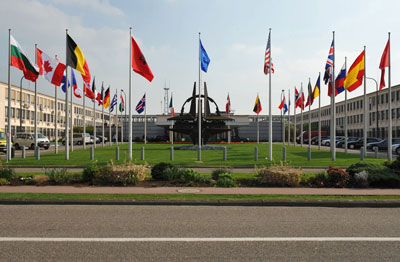
NATO photo 20100416-100415q-HQ28-002
NATO Headquarters, Brussels, Belgium.
The Requirements of Success: NATO’s Force Posture and the New Strategic Concept
by Eric Jardine
For more information on accessing this file, please visit our help page.
Introduction
Throughout the course of its history, the North Atlantic Treaty Organization (NATO) has generated numerous Strategic Concepts. These documents are intended to serve as the basis for its operational doctrine, to provide a cogent assessment of security threats to the member countries, to outline NATO’s basic geopolitical commitments, and to function as a template for political consensus in times of crisis.
In spite of the inherent value of these Concepts, NATO has been faced with a complex and draining war in Afghanistan. Its failure to adequately adapt and perform in this conflict has led some influential political officials to express serious doubt about NATO’s effectiveness, as well as to the likelihood of its continued presence and function. For example, former U.S. Secretary of State, Condoleezza Rice, stated on 6 February 2008: “I do think the alliance is facing a real test here [in Afghanistan…] There are certain allies that are in more dangerous parts of the country, and we believe very strongly that there ought to be a sharing of that burden throughout the alliance.”1 Or, as U.S. Secretary of Defense Robert Gates has stated: “I worry a great deal about the alliance evolving into a two–tiered alliance in which you have some allies willing to fight and die to protect peoples’ security, and others who are not. And I think that it puts a cloud over the future of the alliance, if this is to endure and perhaps even get worse.”2
To contend with these growing tribulations, NATO leaders met in Lisbon in November 2010 to discuss the future of the Alliance, and to generate a new Strategic Concept. It is hoped that this new Concept will rejuvenate the Alliance’s strategic direction. And, according to the former NATO Secretary General Jaap De Hoop Scheffer, such a renewal can best be had by incorporating the “fundamental lessons from our operations in Afghanistan and Kosovo.”3
These intended lessons ought to include the knowledge of the complexity of the operational issues facing the Alliance. First, each state involved has a distinct organizational system of command and control in theatre. This creates a situation wherein the cumbersome nature of the Alliance’s method of hierarchical decision-making — formerly used during the Cold War in large measure to prevent inadvertent escalation to nuclear war — is paired with varying degrees of horizontal incompatibility, as the different national forces face greater operational friction when employed in joint tasks. In terms of doctrine, these issues can be reconciled politically through the North Atlantic Council (NAC) and the processes of consensus building that are indicative of NATO’s structure.4 But, ultimately, the need for a reorganization of the Alliance is derived from NATO’s basic military purpose. For, as Colonel Harry G. Summers Jr. notes: “It is axiomatic in military strategy that one can never factor out the enemy.”5 So, while the NATO member countries could, through the proper cultivation of political will, reconcile the Alliance’s internal issues, each must consciously contend with the fact that NATO is increasingly challenged by what has been described as a highly mobile and adaptive “fourth generation enemy.”6 That is, NATO’s cohesion is being tested by opposing forces that have learned that the accumulation of small political and military defeats can bring down giants; and, that the Alliance, so effective during the Cold War when its forces were not actively employed in a combat role, faces great problems in adapting to the remarkable fluidity of the emerging international environment.7
This point intimates the second reality of NATO’s post-Cold War context, that, in contrast to the Cold War situation where force posture and troop deployment produced success through the logic of deterrence, NATO forces are now being employed, and, therefore, both the credibility and effectiveness of the Alliance are brought into general question. As General Wesley K. Clark, the Supreme Allied Commander Europe (SACEUR) noted during the time of the Alliance’s commitment to operations within Kosovo: “Once we began to use force, we had to succeed.”8 As he further maintained, “we put NATO’s credibility on the line. We have to follow through and make it work. There’s no real alternative now.”9
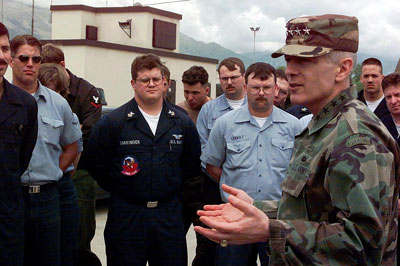
DefenseImagery.mil photo by SRA Mitch Fuqua
On 9 May 1999, General Wesley Clark, Supreme Allied Commander of Europe, visits Navy and Marine maintainers deployed to Aviano Air Base, Italy, in support of NATO Operation Allied Force.
These operational and political realities beg the primary research question that had guided this article: Given the history of NATO’s engagement in Kosovo and Afghanistan, what should have been the central military components of the new NATO Strategic Concept? In response, I propose three components that should have been included in the new Strategic Concept if we want the Alliance to remain at the centre of our national security strategy. First, the entire Concept ought to be grounded in the recognition that NATO’s new security environment is characterized by a different strategic principle than that of the Cold War. That is, that force deployment no longer results in security and that now NATO forces must also be functional when actively employed in combat roles. Second, in recognizing the decentralized and mobile nature of contemporary non-state military security challenges, any new Strategic Concept should embrace the face of battle and prescribe a force posture that emphasizes the decentralization of command and control into the theatre of operations. Third, such a proposition must also contend with the fact that NATO is a consensus-driven alliance, and that open-ended and authoritative prescriptions with respect to force posture and command and control will likely be greeted with a considerable degree of marked skepticism. Thus, drawing from the evidence of NATO’s wars in Kosovo and Afghanistan, I propose that an operative caveat be included that ‘delimits’ the times at which the clause would hold an effect. Essentially, because NATO undertakes both voluntary (Kosovo) and involuntary (Afghanistan) wars, the functionality of the proposed command and control component ought to be directly contingent upon the type of war that is being waged.
To determine the validity of these proposed ideas, I present an analysis of two case studies. The first case considers the employment of NATO forces in Kosovo, assessing the impact of the employed command and control systems through the lens of the 1991 Strategic Concept. The second case considers the International Security Assistance Force (ISAF) mission in Afghanistan, interpreted through that most recent 1999 Concept.
The bulk of this article was written in the spring of 2010. It was presented as a paper at an Atlantic Council of Canada conference on NATO’s New Strategic Concept and was published in an ‘in-house’ edited volume that was later sent to NATO headquarters in order to contribute to the dialogue over what the new Concept should include.10 In the conclusion of the current article, I provide an update to this analysis of NATO’s new Strategic Concept — Active Engagement, Modern Defence — in light of the original findings of the two case studies.
The 1991 Strategic Concept
The end of the Cold War was a tumultuous time. For even as the political cohesion of the Warsaw Pact began to crumble — giving hope to the millions of oppressed people in its satellite countries — the absolute percentage of Soviet Union armament expenditures continued to increase, and the old logic of the Cold War seemed so firmly entrenched as to preclude a peaceable resolution.11 Yet, the breaking down of the Berlin Wall in 1989 symbolized the culmination of a series of events that had really been fermenting and in process for many years. Shortly thereafter, on 6 June 1990, NATO began to respond to these changes in its geo-strategic environment. First, it issued the London Declaration, which recognized the imminent demise of the Soviet Union as it had previously been understood. The Declaration affirmed: “…[that] the Soviet Union has embarked on the long journey towards a free society.”12 Yet, it also reiterated NATO’s purpose, stating: “We will remain a defensive alliance and will continue to defend all the territory of all our members. We have no aggressive intentions and we commit ourselves to the peaceful resolution of all disputes.”13
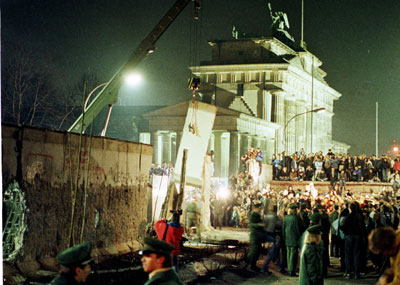
REUTERS/Str Old
Dismantling of the Berlin Wall, 20 February 1990.
NATO further responded by undertaking an internal strategic review.14 As the London Declaration stated:
NATO will prepare a new allied military strategy moving away from ‘forward defence’ where appropriate to reflect a reduced forward presence and modifying ‘flexible response’ to reflect a reduced reliance upon nuclear weapons. In that connection NATO will elaborate new force plans consistent with the revolutionary changes in Europe.15
At the Rome Summit held on 8 November 1991, the NATO countries issued a new Strategic Concept to contend with the rapid changes in the international security environment. The Concept affirmed the changing nature of the security environment stating: “… [that] the monolithic, massive and potentially immediate threat which was the principal concern of the Alliance in its first forty years has disappeared. On the other hand, a great deal of uncertainty about the future and risks to the security of the Alliance remains.”16
It was also recognized that, with the removal of the Soviet threat, an unfamiliar degree of fluidity had returned to the conduct of international affairs. And so, “… in contrast with the predominant threat of the past, the risks to Allied security that remain are multi-faceted in nature and multi-directional, which makes them hard to predict.”17 NATO’s military forces, then, in order to respond to this proliferating list of risks and threats, needed to adapt as well. As General John Galvin, the SACEUR at the time of the Rome Summit, optimistically stated: “Our military forces will be capable of several missions, including deterrence and support for crisis management, peace-keeping, humanitarian assistance, and, as before, the defense of Alliance territory.”18
It is here—within such an optimistic claim—that the crucial connection between the Alliance’s Strategic Concepts and its military strategy emerges. NATO’s Military Committee (MC) employs the templates of force posture and command and control held in the latter sections of the Alliance’s Strategic Concept as the basic constraints upon its resultant military strategy. There was potentially some value, then, to the claim made in the 1991 Concept: “… to ensure that … the Allies’ forces can play an effective role in both managing crises and in countering aggression against any Ally, they will require enhanced flexibility and mobility and an assured capability for augmentation when necessary.”19 This advocated force posture could, perhaps, have gone a long way towards providing a sound template for military action. Yet, as the next section on NATO’s Operation Allied Force demonstrates, the connection between the prescribed force posture elements of the Strategic Concept and the emergent military action was missing a central component.
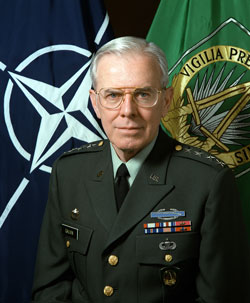
DefenseImagery.mil photo by Russell F. Roederer
General John Galvin, US Army.
Operation Allied Force: The Kosovo Campaign and its Implications
After the limited successes of the US-negotiated Dayton Accords in 1995, which ended, in a somewhat strained manner, the violence in Bosnia-Herzegovina; and, following the failure of the Rambouillet Peace Talks and the escalation of Serb violence against the 90 percent ethnic Albanian population in the province of Kosovo, NATO authorized an “activation warning” in an effort to dissuade Yugoslavia’s President, Slobodan Milosevic, from further violence.20 Amidst an integrated process of consensus-building in order to make a final decision as to whether to proceed to war, the NATO member nations attempted this act of coercive diplomacy.21 Their valiantly derived and potentially effective act of diplomacy, backed by the threat of force, failed to result in a cessation of violence, however. And so, on 24 March 1999, NATO launched Operation Allied Force, which called for intensive air strikes of Serb forces, logistical facilities, and other high-valued military targets.22
The Allied air strikes gradually assumed a thundering momentum. Thirteen out of the nineteen NATO member states contributed aircraft, and nine out of these thirteen undertook combat operations. Indeed, over the course of the 78-day air campaign, over 35,000 sorties were flown, and 23,000 individual munitions were expended.23 The ultimate purpose of the initiated military campaign — undertaken by means of air strikes, and, eventually, by the threat of a ground invasion — was to attack “… the Yugoslav military infrastructure with the objective of deterring future attacks on Albanian Kosovars and degrading the ability of Yugoslav forces to carry on these operations.”24 In particular, NATO forces were to attack airfields, air defence systems, military barracks, and artillery pieces positioned in southern Serbia, communications centres, and some equipment production facilities. As the campaign continued, more targets were, of necessity, added. These additions included logistical support facilities, arms dumps, the national television network, and the electrical system. However, despite the rather widespread sharing of sortie missions by different Alliance members on the basis of contributed capabilities, the targeting of each site was further subject to a cumbersome system of dual decision and review. The military commanders of Allied Force would decide upon a target, and would then have to select, on the basis of nationally derived prerogatives and rules of engagement, which country’s forces could be used in a particular operation. Moreover, in a process that worsened over the life of the conflict, all targeting decisions had to move vertically to the United States command structure, and to the Atlantic Council, before receiving a final approval. Such a duplication of decision-making and the secondary specification for targeting is not uncommon in Alliance actions. For stationary targets, such as those just presented, there was little lost in immediate tactical effect by extending the bombing period over time, in order to reconcile the internal alliance command and control issues.
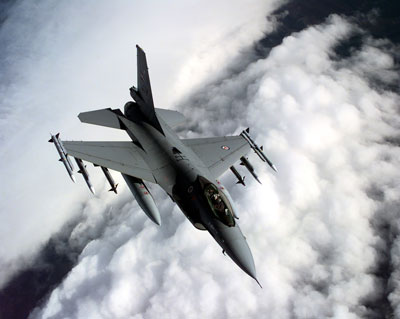
DefenseImagery.mil photo by SRA Greg L. Davis
A Norwegian F-16 with an operational load, Kosovo, 1999.
This loss of only nominal tactical efficacy, however, was outweighed by both political and strategic advantages that could have been obtained through the rapid targeting and destruction of targets within Serbia. Politically, the demonstration of resolve and the rapid destruction of targets by air assets carry with it a weight that can compel desired behavior from one’s opponents.25 Here, interesting substantiation can be drawn from the morale effect of previous air campaigns, wherein the magnitude of a bombing run and its temporal compression tend to enhance both the psychological effects of the attacks and to reduce the extent and effectiveness of enemy adaption.26 Thus, as General Wesley K. Clark, SACEUR, noted, “War has a logic and dynamic all its own and … a strategy of half-hearted incrementalism was likely to fail.”27
The more time the Serbs had to prepare for air strikes, the less real damage would be done, and less political effects would be generated by the attacks. This amounted to the same rudimentary problem found in all strategies of punishment: damage must be delivered faster and with a more powerful magnitude than an opponent can withstand and from which that opponent can readily rebuild.28 Politically, NATO’s gradual escalation of the use of air power signaled trepidation and a transient level of commitment to Milosevic; a signaling which was largely a derivative of the cumbersome system of command and control indicative of NATO military actions.
Strategically, the extension of the bombing period in time reduced its potential military effect, even on static targets, such as those which were initially selected for bombing. This is because countermeasures could be adequately undertaken, with essential mechanical and electronic components of logistical facilities and production shops being moved to alternative locations, and air defence systems possibly prepared in order to attempt to bring down NATO aircraft.
Yet this problem — ultimately derived from an absence of political consensus over the commission of the war and exacerbated by the in-place system of command and control — was also compounded by the military reality of NATO’s opponent: the Serbian military forces. As General Clark noted of the Serbian position, attacks on static targets were of a secondary effect. For Milosevic’s primary centre of gravity was, not his industry, but his armed forces.29 And so, “We wanted to go after Milosevic’s ‘center of gravity,’” General Clark writes, “… the source of his power and strength.”30
The targeting and destruction of the ground forces was, therefore, essential. As was to become quite apparentthroughout the extent of the campaign, air strikes on Serbian troops were highly ineffective at their purpose.31 The central crux of this issue was that NATO, as a complex political-military alliance, could not adapt and learn as quickly or effectively as its opponents. As one NATO commander involved in Operation Allied Force noted: “We have a process challenge, not a resource challenge. We should not substitute force flow for strategy. We do not need additional resources.”32And as General Clark later noted, this war “… was [essentially] an adaptive process and the Serbs were learning, too.”33
In this particular case, Serb adaptation could not occur with only direct reference to NATO forces, as the presence of the Kosovo Liberation Army (KLA) entailed some martial contracts within the province that would need to be confronted directly. But the Serbian military was more materially capable than the KLA. Thus, “each day, the organized KLA diminished,” noted General Clark, “and this, in turn, meant that the Serb forces could reposition, disperse and hide from our aircraft.”34 Essentially, as the Serb forces neared the completion of their primary military-political task, the relative impact of NATO forces diminished. The best opportunity to defeat the Serb forces, therefore, was in the initial stages of the conflict.
The 1991 Strategic Concept called for ‘flexible and highly mobile’ NATO forces to fulfill the new security tasks that confronted the Alliance—such as instability and ethnic warfare in Kosovo—yet the sub-optimal outcome that was obtained belies the potential effectiveness of the Concept’s proposal. The problem here is found in the necessary distinction between force posture and implementation. Thus, the crucial issue in the Kosovo campaign, was, as Steven Bowmen noted in a Congressional Research Brief, the trouble generated by ‘command by committee,’ which “… hampered NATO military leaders’ ability to wage an effective, rapidly responsive campaign. Target lists, weapons used, forces deployed were all subject to prior approval by all NATO governments. This slowed decision making, constrained operations, and sometimes emphasized political over military considerations.”35 And while an unclassified After-Action Report on Kosovo and Operation Allied Force rightly illustrates that with regards to all command and control issues, “… any discussion of NATO-U.S. decision making processes must begin with the simple fact that the process worked,” the tensions nevertheless abounded and the actual conduct of the war was more troubling than necessary.36 Indeed, that same report concludes that NATO needed to improve its “political-military process,” particularly through enhanced contingency planning for out-of-area operations, a politically agreed-upon process for policy implementation, a unified structure of command and control, as well as a strengthening and enhancement of NATO’s political-military interface.37
Had these prescriptions been implemented they would have found their earliest root in the 1999 Strategic Concept, which was drafted and issued on 23-24 April, even as the Kosovo Campaign raged.
The 1999 Strategic Concept
The 1999 Strategic Concept marked the 50th anniversary of the NATO alliance. In its assessment of NATO’s geostrategic environment, it provided a more expansive list of security threats than its predecessor. It also expanded the “fundamental security tasks” of the Alliance, to include security provision, consultation, deterrence and defence, crisis management, and partnership.38 In many respects, NATO, in search of a cohesive external threat to provide the Alliance with a justification for its very existence had now proliferated the enumerated security threats to an almost encyclopedic extent. The logic behind such a desperate search for meaning is simple. As Glenn Snyder has noted, it is often taken: “… [that] alliances have no meaning apart from the adversary threat to which they are a response.”39
Some officials, such as former Secretary of State Warren Christopher, and former Secretary of Defense William Perry, are champions for both such an expansion of threats, but also for the use of NATO as “… an instrument for the projection of force anywhere the West’s ‘collective interests’ are threatened.”40 Indeed, the expansion of the prospective threats tends to increasingly illustrate a possible global commitment for the Alliance.41 This has also given increased salience to Article II of the North Atlantic Treaty, and the function of NATO as a democracy promoter with all that such a role entails, including alternative systems of civil-military relations, a provision of security to foster democratic transitions, and support for regime consolidations.42
This nascent possibility of a global commitment was given an externally derived and destructive impetus on 11 September 2001, and the primary form of response has not been contingent upon Article II, but, instead, has been one of collective self-defence, that is, an Article V response. The 11 September terrorist attacks on New York and the Pentagon resulted in the Alliance’s first ever invocation of its collective defence clause, Article V. Indeed, the collective sentiment that was expressed after these attacks was almost overwhelming, as one statement of the North Atlantic Council indicated: “At this critical moment, the United States can rely on its 18 Allies. … NATO solidarity remains the essence of our Alliance. Our message to the people of the United States is that we are with you. Our message to those who perpetrated these unspeakable crimes is equally clear: you will not get away with it.”43 Also, the determination to employ NATO military forces to address this challenge was clear. As then-Secretary General of the Alliance, Lord Robertson, stated: “These barbaric acts constitute intolerable aggression against democracy and underline the need for the international community and the members of the alliance to unite their forces in fighting the scourge of terrorism.”44 Thus, while a consensus to invoke Article V was necessary, once that choice had been made, any military action that was to follow was no longer a war of volition, but was instead a war of need. Herein, the member countries of NATO had placed the future of the Alliance on the line and now had to successfully complete any resultant task.
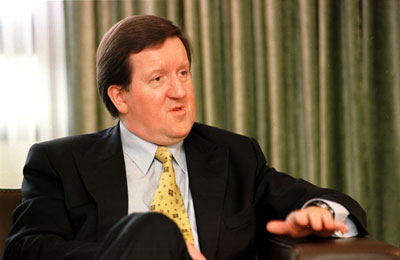
NATO photo b-robert2_lordrobertson
Lord Robertson.
The 1999 Concept, partially as a response to early analysis of the Kosovo mission, had included a more rigorous section on force posture, even raising some issues of command and control. The Concept called for more coherent “procedures for consultation, an integrated military structure, and co-operation agreements.”45 It also reiterated the need for mobility and flexibility in operations, “… in both the near and the long term and for the full range of its mission, [NATO will] require essential operational capabilities such as effective engagement capability; deployability and mobility; survivability of forces and infrastructure; and sustainability, incorporating logistics and force rotation.”46
As with the 1991 Strategic Concept, this most recent attempt did an adequate job of indicating the scope of possible political-military issues, and prescribing actions to overcome them in a preparatory sense. As we shall see with respect to NATO’s military action in Afghanistan, however, the central problem which emerges is that both of these post-Cold War Strategic Concepts speak only to the actions involved in the preparation for war, while largely ignoring the actual conduct of war.47
Afghanistan: Operation Enduring Freedom (OEF) and the International Security Assistance Force (ISAF)
Afghanistan has a long and war ridden history; a narrative that is filled with the repulsion of invaders, and associated with extensive political ramifications.48 Yet, America and its allies were drawn into this country by the Taliban’s refusal to turn over Osama Bin Laden in the weeks that followed the 11 September attacks. By 26 September 2001, US covert operatives had infiltrated Afghanistan’s northern portion to make contact with the leadership of the United Islamic Front for the Salvation of Afghanistan, also known as the Northern Alliance.49 By 15 October, these teams had made contact and had begun planning “… for [a] combined offensive action against the Taliban.”50 As the joint offensive proceeded southwards, the Taliban forces organized into large formations to stop their advancement.51 This action made the Taliban fighters particularly vulnerable to US and UK air strikes, which quickly decimated their ranks. By 8 December 2001, the Taliban and al-Qaeda forces had abandoned the cities, and fled to the mountainous regions of the southernmost provinces of Helmand and Kandahar, along the Pakistani border.52
The enemy had learned. It had adapted to US, UK, and allied strength by dispersing and assuming a more networked and decentralized method of war fighting. Yet, large US unit operations continued. During Operation Anaconda in 2002, for example, more than 2000 US and allied forces swept the mountains in Afghanistan’s eastern regions, and while these operations resulted in some 500 Taliban deaths, it was beginning to be recognized that a different form of warfare had begun to emerge. As then-CIA Director George Tenet stated in late-2002: “You’re entering into another phase here that is actually more difficult, because you’re probably looking at smaller units that intend to operate against you in a classic insurgency format.”53 The Taliban had now adopted the loose characteristics of a “fourth generation enemy.” That is, they now employed “… a networked, flexible force that avoids contact except on its own terms. It focuses on low-intensity activities.”54
By late-December 2001, the United Nations had mandated an International Security Assistance Force (ISAF). By August 2003, NATO had assumed full operational responsibilities for the ISAF mission in Afghanistan. But, following the US diversion of political focus and troops to Iraq in early-2003, there was also a divergence of opinion over NATO’s presence and proper role in Afghanistan.55
NATO’s ISAF mission is the largest out-of-area operational force that has been employed in the Alliance’s history, consisting of 41,000 troops.56 Many nations have, due to domestic political reasons, imposed strict national caveats upon the use of their forces. Germany and Italy, for example, will not allow their forces to be used in combat operations in the southern provinces. The effect upon NATO’s forces is a drastic reduction in its employable contingents. Thus, while NATO’s deployment is equivalent to about four divisions of troops, “… in most military engagements it is able to fight effectively at no more than battalion level.”57 The result is that, in most cases involving the actual employment of troops, NATO’s resources appear to be lacking. As Lieutenant General David Richards, the Commander of NATO forces from July 2006 to February 2007 stated:
Our force levels in 2006 were just sufficient to contain the insurgency. Significant capability gaps remain that restricted my ability to reinforce where the situation dictated. As a result of too few forces, we have found it difficult to maintain security where we have gained it. … Given the nature of the insurgency that we are now fighting, we should look again at force requirements and adjust as necessary.58
But, as with the NATO employment in Kosovo, the issue is not really a resource challenge, it is a process challenge. As Ilana Bet-El and General Rupert Smith have noted: “… to a certain extent, size in itself is not the priority problem. Afghanistan has shown the difficulties this Cold War relic [NATO] has when facing modern warfare, no matter the troop levels.”59
With the major tactical defeat which the Taliban received during the course of Operation Medusa in 2006, NATO is no longer confronted by any large scale formations that would present, either a singular existential danger to the ISAF mission, or a functional target for more NATO troops. The result is that the tactical situations have become more complex. These engagements are now less determined by technology and military material, and more by the small-unit skill of NATO forces. And so, as Lieutenant General Richards further notes: “… as the complexity of operations develops, we need to adapt our preparation and training. All our soldiers need to be able to handle complex and sophisticated situations.”60
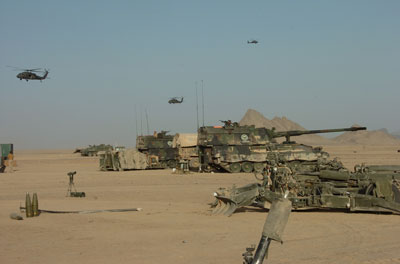
DND photo AR2006-P008-0030 by Sergeant Lou Penney
Operation Medusa.
The real issue, then, is that the enemy which NATO confronts “… constantly refines its tactics through experimentation, widely disseminates its findings through the media, and supports its semi-independent cells through travelling trainers.”61 Thus, NATO is confronted by an adversary whose strategy is to commit one thousand small cuts upon the perceived occupiers, to essentially drain the enemy of its will to fight, and to slowly obtain victory. Under these protracted circumstances, it is clear that NATO forces “… must be capable of resisting each cut individually. That can only be done by the forces present at the time of the cut, regardless of size.”62
Those insurgent forces that are challenging NATO are able to employ such damaging small-unit tactics because they lack any standardization of doctrine, which allows for constant tactical innovations. Essentially, in terms of their military purpose, the insurgents are only marginally directed from any central source, and thus are able to exploit weakness and follow-up on tactical advantages. In contrast, NATO forces are directed from the centre, both in terms of the vertical nature of the Alliance structure, as well as the horizontal command and control issues that are derived from the various national governments. Yet, small-unit forces that are adaptable and flexible in their tactics are crucial to success in this type of war fighting.63 Thus, as RAND analyst Seth G. Jones maintains: “Perhaps the most significant command and control lesson that can be learned from the counterinsurgency in Afghanistan was the need to decentralize authority to the small unit level.”64 As Jones further notes, to obtain this necessary form of command and control “… means giving infantry commanders the responsibility, autonomy, and distance from higher headquarters that is now held only by special forces. … Commanders must empower small-unit leaders to deal with the challenges encountered during counterinsurgency operations, including the authority to routinely make decisions currently made by battalion and brigade combat team commanders.”65
“Active Engagement, Modern Defence”
As was the case with the 1999 Strategic Concept, NATO undertook the planning, drafting, and adoption of its new Strategic Concept, “Active Engagement, Modern Defence,” in the midst of an ongoing operation—namely, the war in Afghanistan. As this conflict continues, I am certain that the precepts of the new Concept will appear increasingly outdated. The new Concept is not overly predictive or forward looking, but, when viewed on the basis of NATO’s past operations, it does incorporate many principles that ought to improve its military effectiveness.
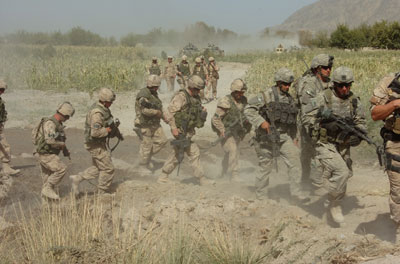
DND photo AR2006-P008-019 by Sergeant Lou Penney
Operation Medusa.
Conclusion
In this article, I have argued that, on the basis of NATO’s two main post-Cold War expeditionary operations—Kosovo and Afghanistan—the Alliance ought to have incorporated three features into its newest Strategic Concept: 1) an emphasis upon the actual employment of forces; 2) a decentralization of command and control; and 3) a prescription emphasizing greater burden-sharing across the Alliance, even to the level of drawing a distinction between voluntary and involuntary wars.
The evidence from Kosovo and Afghanistan suggests that NATO needed to recognize that the international security environment has radically changed since the end of the Cold War. Specifically, that the deployment of NATO forces for deterrent purposes is no longer sufficient to achieve the security of its member countries. The Alliance can now achieve security only through the active employment of its forces.
In some respects, the new Strategic Concept does capture this component within its numerous prescriptions. While dressed in more politically correct language than I have provided here, the new Concept does state that the Alliance will “… develop and maintain robust, mobile, and deployable conventional forces to carry out our Article V responsibilities and the Alliance’s expeditionary operations.”66 Put otherwise, it will effectively maintain its employable forces. Similarly, it is further noted that, to retain a functional allocation of resources, NATO must now “… maximize the deployability of [its] forces, and their capacity to sustain operations in the field, including by undertaking focused efforts to meet NATO’s usability targets.”67 Again, while the language emphasizes the ‘deployability’ of NATO forces, the implicit emphasis is placed upon the actual use of forces in combat and complex expeditionary roles.
The second proposed component—a decentralization of command and control—also finds some representation in the new Concept. The emphasis is now placed upon the need for integrated civilian, development, and military operations, with inherently decentralized forms of war and military operations being given a place of prominence. In this regard, the Concept notes: “The lessons learned from NATO operations, in particular in Afghanistan and the Western Balkans, make it clear that a comprehensive political, civilian, and military approach is necessary for effective crisis management.”68 Moreover, it is also noted that in order to retain its effectiveness NATO, must now “… develop doctrine and military capabilities for expeditionary operations, including counterinsurgency, stabilization and reconstruction operations.”69 As highlighted during the case analysis, effective counterinsurgency and other types of modern operations are inherently decentralized. By emphasizing these types of operations, the new Strategic Concept notes, again implicitly, that command and control prerogatives ought to be devolved as much as possible and practicable.
This leaves only the final component, namely, that an authoritative provision be made to ensure the equitable and active participation of all NATO member nations in future expeditionary operations. As a distinctly political prescription, and one that trammels upon member nations’ sovereignty and national prerogatives, this aspect is clearly the least likely to find any representation in the new Concept. It is not surprising, then, that the only reference to burden-sharing or the need for solidarity of purpose within NATO operations is minimal and quite lacking in specificity. In the section on core principles and tasks, the new Concept posits: “The security of NATO members on both sides of the Atlantic is indivisible. We will continue to defend it together, on the basis of solidarity, shared purpose and fair burden-sharing.”70 This prescription lacks specification, particularly a clear definition of “fair burden-sharing.” The new Concept is not, therefore, divorced from the politics of its member nation states. It grants them all the full rights and autonomy of their national prerogatives. In many ways, this is inevitable and totally expected. It is also pragmatic and politically motivated.
Yet, while these characteristics are possibly virtues, the absence of a clear and authoritative statement on the complexity of undertaking joint-operations in a world that increasingly demands active and cooperative military action is a liability. Several NATO member countries will inevitably free-ride upon the security guarantee provided by the Alliance, and fail to contribute to both present and future operations in an equitable manner. But, while this is an issue, it is potentially less a failure of the Strategic Concept than a failure of the political solidarity of the Alliance itself. In the future, when NATO is called upon again to act in a collective manner, we must only hope that the leaders of the member countries still see the value in the Alliance. In this respect, the fact that two of the three prescribed components of a new and functional Concept, as presented in this paper, are represented in the new Strategic Concept, might just be a harbinger of blessing. It demonstrates that the Alliance has learned from past operations and evolved in its approach. In fact, it might just mean that the Alliance can, indeed, increase its military functionality in the contemporary world.
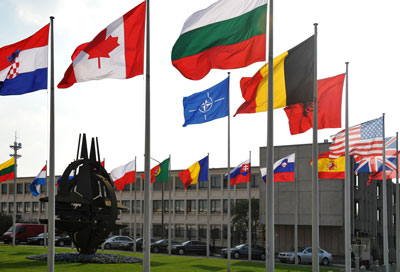
NATO photo 20100416_1000415a-HQ28-006
![]()
Eric Jardine is a Ph.D Candidate in the Norman Paterson School of International Affairs and the Doctoral Research Fellow at the Centre for Security and Defence Studies, Carleton University. His published articles on counterinsurgency and military strategy have appeared in Parameters, Military Review, Defense Studies, Small Wars Journal, The Journal of Military and Strategic Studies, SITREP, On Track, and Strategic Datalink. His Doctoral research focuses upon the dynamics of population-centric counterinsurgency and urban bias.
Notes
- Condoleezza Rice, cited in, “NATO Facing ‘Real Test’ in Afghanistan: Rice,” CBC NEWS (Wednesday, 6 February 2008), p. 1.
- Ibid., p. 1.
- Jaap De Hoop Scheffer, cited in, “NATO Chief Calls for New ‘Strategic Concept,’” in International Herald Tribune (11 February 2007).
- Douglas L. Bland, The Military Committee of the North Atlantic Alliance: a Study of Structure and Strategy (New York: Praeger Security International, 1991), pp. 9-11.
- Harry G. Summers, Jr., On Strategy: A Critical Analysis of the Vietnam War (New York: Presidio Press, 1955), p. 71.
- For a thorough discussion of the concept of ‘fourth generation warfare’ see, for example, Thomas X. Hammes, The Sling and the Stone: On War in the 21st Century (New York: Zenith Press, 2006).
- Eric Jardine, “The Weight of History in NATO’s Future Course: A Critical Analysis of Vertical and Horizontal Danger,” Sabrina Hoque (ed.), (Halifax: Centre for Foreign Policy Studies, forthcoming).
- Wesley K. Clark, Waging Modern War (New York: Public Affairs, 2002), p. 202.
- Ibid., p. 171. Emphasis added by this author.
- Eric Jardine, “Wars of Volition and Wars of Need: NATO’s Force Posture and the Commitment to Battle,” in A New Strategic Concept for NATO (Toronto: Atlantic Council of Canada, 2010), pp. 87-103.
- As one cited study indicates Soviet Arms spending increased from 26 percent in 1985, when Mikhail Gorbachev took office, to a staggering and, ultimately, a crippling level of 36 percent in 1991. See Peter Duignan, NATO: Its Past, Present, and Future (Stanford: Hoover Institute Press, 2000), p. 47.
- London Declaration 6 July 1990. NATO online library, p. 1.
- Ibid., p. 2.
- Ivo H. Daalder, The Nature and Practice of Flexible Response: NATO Strategy and Theater Forces Since 1967 (New York: Columbia University Press, 1991), p. 292.
- London Declaration 6 July 1990. p. 5.
- The Alliance’s Strategic Concept (Rome: 8 November 1991), p. 2.
- Ibid., p. 3.
- J.R. Galvin, “From immediate defence towards long-term stability,” in NATO Review, Vol. 39, No. 6 (December 1991), p. 15.
- The Alliance’s Strategic Concept, p. 11.
- Steve Bowman, Kosovo and Macedonia: U.S. and Allied Military Operations (CRS issue Brief for Congress, 2003), pp. 1-3.
- David P. Auerswald, “Explaining Wars of Choice: An Integrated Decision Model of NATO Policy in Kosovo,” in International Studies Quarterly, Vol. 48 (2004), pp. 631-662.
- For a detailed description of the tense Alliance negotiations that led to this action see, Wesley K. Clark, Waging Modern War (New York: Public Affairs, 2002), pp. 107-161.
- Ibid., p. 3.
- Steve Bowman, Kosovo and Macedonia…, p. 3.
- See Robert A. Pape, Bombing to Win: Air Power and Coercion in War (Ithaca, NY: Cornell University Press, 1996).
- Irving L. Janis, Air War and Emotional Stress: Psychological Studies of Bombing and Civilian Defence (Toronto: McGraw-Hill Book Company, 1951), pp. 98-125.
- Wesley K. Clark, Waging Modern War (New York: Public Affairs, 2002), p. 252.
- For an interesting discussion of countermeasures in air campaigns see, for example, Mark Clodfelter, The Limits of Air Power (Lincoln: University of Nebraska Press, 2006).
- Clark provides a rationale for why the Serb military forces where a foremost center of gravity. See Wesley K. Clark, p. 260.
- Ibid., p. 241.
- H. John Poole, Phantom Soldier: the Enemy’s Response to U.S. Firepower (Emerald Isle, NC: Posterity Press, 2001), p. 219.
- Anonymous NATO commander, cited in Wesley K. Clark, p. 250.
- Ibid., p. 276.
- Ibid., p. 251.
- Steve Bowman, Kosovo and Macedonia: U.S. and Allied Military Operations (CRS issue Brief for Congress, 2003), pp. 3-4.
- Kosovo/Operation Allied Force After-Action Report (Report to Congress: 31 January 2000), p. 16.
- Ibid., p. 127.
- NATO Press Release NAC-S(99)65 – 24 April 1999, The Alliance’s Strategic Concept, p. 3.
- Glenn H. Snyder, Alliance Politics (Ithaca: Cornell University Press, 1997), p. 192.
- Ted Galen Carpenter, “NATO’s New Strategic Concept: Coherent Blueprint of Conceptual Muddle?” in Journal of Strategic Studies,23:3 (September, 2000), p. 11.
- Ivo Daalder and James Goldgeier, “Global NATO,” in Foreign Affairs, Vol. 85, No. 5, (September/October 2006), pp. 105-113.
- Daniel N. Nelson, “Civil Armies, Civil Societies, and NATO’s Enlargement,” in Armed Forces & Society, Vol. 25, No. 1 (Fall 1998), pp. 137-160.
- Statement by the North Atlantic Council, Press Release, PR/Cp (2001)22 (11 September 2001).
- Statement by the Secretary General of NATO Lord Robertson, Press Release, PR/CP (2001)121 (11 September 2001).
- NATO Press Release NAC-S(99)65 – 24 April 1999, The Alliance’s Strategic Concept. p. 12.
- Ibid., p. 15.
- This idea is rooted in Clausewitz’s views on strategy, as will become apparent in the analysis of NATO operations in Afghanistan. It is also found, however, in Colonel Harry G. Summer’s analysis of the Vietnam War. See Harry G. Summers, Jr., On Strategy…
- For a good account of Afghanistan’s more recent history, see Ahmed Rashid, Taliban (New Haven, CT: Yale University Press, 2001).
- Daniel Marston, “Lessons in 21st-Century Counterinsurgency,” in Daniel Marston and Carter Malkasian (eds.), Counterinsurgency in Modern Warfare (New York: Osprey Publishing, 2008), p. 223.
- Stephan Biddle, Afghanistan and the Future of Warfare: Implications for Army and Defense Policy (Carliste: USAWE SSI, 2002), p. 8.
- Daniel Marston, “Lessons in 21st-Century Counterinsurgency,” p. 225.
- Ibid.
- George Tenet, cited in Ibid., p. 226.
- Thomas X. Hammes, p. 167.
- Ilana Bet-El and Rupert Smith, “The Bell Tolls for NATO,” in National Interest (January/February 2008), p. 64.
- This section was originally written in June 2009. Troop quantities will have likely shifted since this time.
- Ibid., p. 64.
- David Richards, “A Firm Foundation,” in NATO Review (Spring 2007), p. 2.
- Ilana Bet-El and Rupert Smith, “The Bell Tolls for NATO,” in National Interest (January/February 2008), p. 65.
- David Richards, p. 2.
- H. John Poole, Tactics of the Crescent Moon: Militant Muslim Combat Methods (Emerald Isle, NC: Posterity Press, 2004), p. 192.
- H. John Poole, Militant Tricks: Battlefield Ruses of the Islamic Insurgent (Emerald Isle, NC: Posterity Press, 2005), p. 261.
- Seth G. Jones, Counterinsurgency in Afghanistan (Santa Monica, CA: RAND Publishing, 2008), p. 98.
- Ibid., p. 97.
- Ibid., p. 99.
- Strategic Concept for the Defence and Security of the Members of the North Atlantic Treaty Organisation, in Active Engagement, Modern Defence (Lisbon: November 2010), Section 19. 3.
- Ibid., Section 37. 1.
- Ibid., Section 21.
- Ibid., Section 25. 2.
- Ibid., Section 3.






